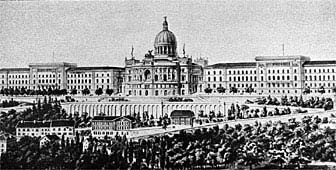Bastion of Swiss democracy celebrates a century

It's 100 years since the inauguration of Bern's most prominent building and the centrepiece of Swiss democracy - the federal parliament.
Overlooking the River Aare and with a commanding view of the Bernese Oberland, the federal parliament or “Bundeshaus” is a grand building in every sense of the word with its Florentine architecture and central dome. But it might have looked very different if one particular design had met with approval.
In the mid-1850s, plans were drawn up for a neo-Gothic structure which envisaged a Bundeshaus – Palais fédéral in French – bearing a striking resemblance to the Palace of Westminster, or Houses of Parliament, in London.
“It would have looked very strange in such a setting,” admits Monica Bilfinger, an art historian at the federal building department and an admirer of the design which was eventually accepted.
Architecture competition
Originally, the federal parliament was two separate buildings, and when extra space was needed it was decided to fill the gap between them with a larger, dominant structure. Architects were invited to submit plans, and the outcome of the competition came as a surprise to many.
The winner, Hans Wilhelm Auer (1847-1906), could hardly have been described as one of Switzerland’s most prominent architects at the time. Born in St Gallen, he had left the country to study in Vienna, becoming an assistant to his professor.
Not only had Auer not worked as an architect in Switzerland, he had never even visited Bern and didn’t know the city at all.
But his plans for the Bundeshaus received parliamentary approval and the result, 100 years after construction work was completed, is one of Switzerland’s most distinctive and – although it also has many critics – admired buildings.
Swiss iconography
“I like it very much,” says Bilfinger. “But some people dislike the middle section on first appearance because in a sense it is a difficult building. The grandeur and Swiss iconography are not to everyone’s taste. It’s a building which demands a lot of understanding.”
Construction work was actually carried out in accordance with the ideals of Swiss federalism. Although the exterior is mostly sandstone from quarries just outside Bern, stone and other building materials from every region of the country were used.
Similarly, over 30 artists from throughout the country were commissioned to do the artwork, which includes giant frescos.
The chamber of the Senate is dominated by a mural painting of a Landsgemeinde, or traditional open-air cantonal parliament, in Obwalden. The House of Representatives has a landscape of Lake Lucerne and its surrounding mountains entitled “The Cradle of the Confederation”.
In fact the artwork as a whole accounted for 16.5 per cent of construction costs.
Undiscovered secrets
Bilfinger told swissinfo that one of the reasons she admired the Bundeshaus was because it had so much still to reveal. “When I started this job I thought we knew everything about the building. But even today it has many undiscovered secrets and we are still making discoveries.”
For example when a large chandelier from one of the parliamentary chambers was recently taken down for restoration, it was found to contain documents written by restorers in the 1930s with their views about the approaching world war.
Like the building materials, the restorers and original construction workers represented most regions of Switzerland. “The Bundeshaus is not just a House for the Swiss people,” says Bilfinger, “it’s made by the Swiss people.”
by Richard Dawson

In compliance with the JTI standards
More: SWI swissinfo.ch certified by the Journalism Trust Initiative
You can find an overview of ongoing debates with our journalists here . Please join us!
If you want to start a conversation about a topic raised in this article or want to report factual errors, email us at english@swissinfo.ch.